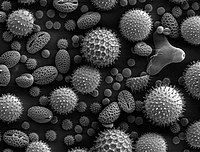
Photo from wikipedia
An approach based on vibrational spectral measurements is described for determining the ionizable group content of ion conducting polymer membrane materials. Aimed at supporting the assessment of membrane stability and… Click to show full abstract
An approach based on vibrational spectral measurements is described for determining the ionizable group content of ion conducting polymer membrane materials. Aimed at supporting the assessment of membrane stability and wear characteristics, performance is evaluated for attenuated total reflection Fourier transform infrared (ATR FT-IR) spectroscopy, confocal Raman microscopy, and ATR FT-IR microscopy using perfluorinated ionomer membrane standards. One set of ionomer standards contained a sulfonic acid ionizable group and the other a sulfonyl imide group. The average number of backbone tetrafluoroethylene (TFE) units separating the ionizable-group containing side chains was in the range of 7.2–2.1 (sulfonic acid set) and 10.5–4.6 (sulfonyl imide set). A poly(tetrafluoroethylene) (PTFE) sample was included as a blank, representing the limit of zero ionizable group (and maximum TFE) content. Calibration relationships were derived from area-normalized vibrational spectra. For all three methods, calibration models applied to independent spectral measurements of samples predicted the ratio of backbone TFE groups to ionizable groups in the repeat unit (m) with a standard error of ≤ ±0.3. The confocal Raman and ATR FT-IR microscopy techniques achieved ideal blank responses and the lowest prediction errors, down to m ± 0.1 at the 90% confidence level. With its relative simplicity, low sample size requirements, and potential for quantitative micron-scale spatial mapping of the ionizable group content within a membrane, the approach has application to advancing materials development, including exploratory synthesis, durability and wear assessment, and in situ studies of membrane process.
Journal Title: Applied Spectroscopy
Year Published: 2018
Link to full text (if available)
Share on Social Media: Sign Up to like & get
recommendations!